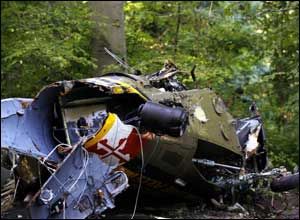By Alan Levin
USA TODAY
 AP Photo The NTSB investigation revealed that the helicopter was not equipped with a warning system to indicate that the pilot was flying too close to trees. |
WASHINGTON — Deaths on air ambulance flights — including four fatalities over the weekend in Maryland — have soared to record levels over the past year, prompting safety advocates to renew calls for stricter controls on medical airlifts.
A Maryland State Police emergency medical helicopter crashed about midnight Saturday in a wooded park, amid fog, according to the National Transportation Safety Board (NTSB). The dead included a 17-year-old girl who had been injured in a car crash, the pilot and two medical workers. An 18-year-old woman, who had also been in a car crash, survived.
This year, 24 people have died on medical flights. The most deaths recorded in a year previously was 18 in 2004, according to NTSB data. The six fatal crashes so far this year equal the highest recorded in any previous calendar year. Over the past 12 months, the trend is even more stark: A total of 31 people have died in eight crashes.
“The safety board is so concerned about this area of aviation safety that we have voted to hold a public hearing on EMS operations,” NTSB member Debbie Hersman said. “This is one of the areas of aviation with one of the highest accident rates overall.”
In 2006, the NTSB issued a special report on air ambulance crashes that called for tighter rules to address the inherent risks of flying helicopters to roadside accident scenes and other dangerous locations. It also sought to require computerized systems that warn pilots when they get too close to the ground.
Hersman said progress has been made, but none of the NTSB recommendations has been fully implemented.
Investigators are months away from pronouncing a cause in the District Heights, Md., case, but it appears to have key factors in common with the bulk of air ambulance crashes. The crash occurred in poor visibility and darkness as weather was deteriorating, Hersman said. The pilot had planned to take the two patients to a hospital but was diverted to nearby Andrews Air Force Base as the weather got worse, she said.
All but two of the past eight fatal accidents have been at night or in poor weather, according to NTSB records. Poor visibility and weather were also named as a key cause of accidents in the board’s 2006 report.
Pressing on in bad weather is “a good way to end up in an accident,” said Gary Sizemore, president of National EMS Pilots Association.
“We’re saddened, and we’re disappointed, and we’re frustrated,” said Dawn Mancuso, executive director of the Association of Air Medical Services. She said she had just attended a helicopter safety summit with the Maryland State Police on Friday.
The U.S. House and Senate are considering legislation that would place new standards on the industry.











